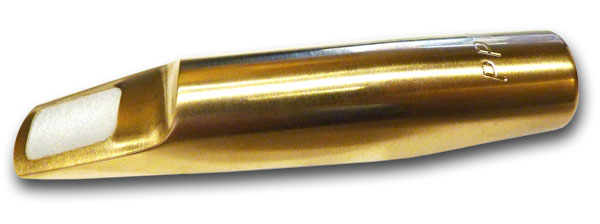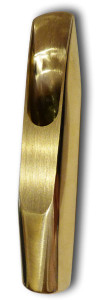
I recently had the chance to try one of these mouthpieces thanks to a pass-around that Pete put together through Sax on the Web Forum. I had practically forgotten that I was supposed to be in it until I started seeing posts from Pete on the forum and I thought I was going to see it almost 2 months ago but the trail went cold. I finally got to see it about two weeks ago but unfortunately I only really had one night with it because I was traveling for a family function and I didn’t want to hold up the pass around. I think I would have obviously been somewhat more comfortable with it given more time but I think my impressions of it as a viable mouthpiece are still valid.

The first two things I noticed about the mouthpiece when I pulled it out of the box were how precise it looked and how hefty it was. Everything about this mouthpiece just says precise when you look at it. The rails and tip are sharp, defined, and even. It’s obvious that a lot of care went into fashioning this mouthpiece. I was also stuck by just how solid it was in my hand. This is one precision hunk of solid metal. It’s also beautiful with a brushed bronze finish and a pleasing shape.
It’s an 8* but it has a rather pronounced baffle so that helps offset the tip opening. Still, 8* is bigger than I like to play these days. I tried it with one of my Rigotti Gold 3 1/2 M reeds that’s already broken in and I really liked the control I had but I think the sound was a little stuffier than I would want. I also tried it with an old Java (green) 3 I had in a box and it was much brighter and probably more commercial sounding but it was VERY hard to control. I think I could get used to either approach given more time but for this night I felt more comfortable with the harder reed. I used the included Rovner ligature although it also came with a Marc Jean ligature but I didn’t want to scratch it up since it wasn’t mine.
I absolutely loved this mouthpiece in the lower register and up into the about C3 but I felt it was a little more resistant than I wanted to be in the upper register and it seemed to have a tendency to thin out. This is pretty obvious in the recordings but it was certainly less resistant up there with the softer reed. The registers I liked were thick with lots of pleasing lower overtones but the mouthpiece also has a crispness that made it feel very accurate. It’s definitely a mouthpiece that can get loud when you put air into it – in fact it can take a lot of air without balking. On the other hand it also does a nice job with sub tones. On Pete’s website he talks about trying to create a mouthpiece that could work in many varied musical situations and I think he succeeded in that regard. I can definitely appreciate having one go-to mouthpiece that can be smoky or raucous depending on the needs of a situation. If I was going to hazard a guess I would say that this mouthpiece has a shorter facing length than I am used to but I didn’t measure it or anything – it’s just a thought because it felt like some Beechler’s I’ve tried and they have a shorter facing as well.
One minor complaint I had was the bore of the shank. I played it on my new Cannonball tenor since my Mark VI is in dire need of repair right now. I went to put it on and I could tell instantly that it was much narrower than my other pieces. I tried greasing up the cork really well (I use Doctor’s Products cork grease – something I should probably write about in the future I guess) but it really didn’t help. To make matters worse I really had to crank this puppy on there to get it in tune. I don’t think I got it all the way in to be completely in tune but it was actually shredding the cork in places and I just had to stop. You can probably hear some of the resulting intonation issues in the recording. Part of the problem is the narrowness of the bore but I think the sharp edge was also a problem. Maybe if it had some taper at the end and the edges were more rounded it wouldn’t be so problematic.
In the recording I am playing on the Rigotti Gold 3 1/2 M but I also play a little at the end with the Green Box Java 3. You can hear how it brightens up but what I left on the cutting room floor was how wild and woolly it was with that configuration. It was really very hard to control. I would have loved to have had at least one more night to play on it and I could see myself being happy with this mouthpiece if I wasn’t already pretty well set in that regard. One thing to take into consideration is that all of Pete’s profits on the things he sells on his website go to charity and I think that’s a wonderful thing. If you’re looking for a mouthpiece that will get you through many styles and handle them all well then this might be the one you’re looking for.

would like to try the ppt mouthpiece,what do I have to do? I am also looking for a old power tone sax baffle for my mouthpiece that was sold at the woodwind and brasswood years ago, would be happy to find just one.
You can work though Pete on his website. Here’s the direct link to the mouthpieces. http://tamingthesaxophone.com/saxophone-mouthpiece-tenor-ppt
-Barry